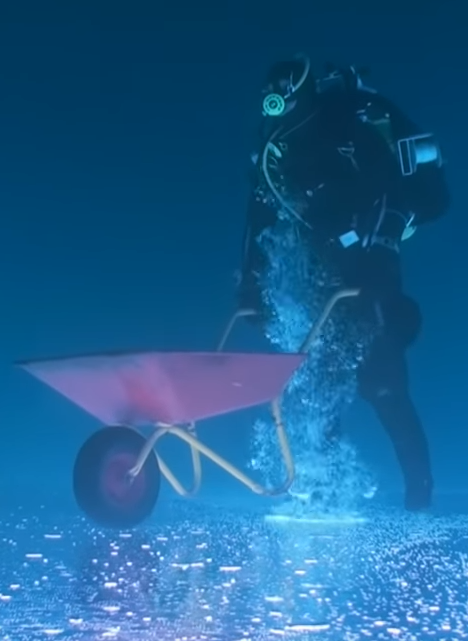Let me share a true story with you. A number of years back, I enrolled in a scuba class with a bunch of friends from work at a YMCA in the suburbs of Chicago. Our instructor was a former U.S. Navy Underwater Demotion Team (UDT) diver who served during the Viet Nam war. So our scuba class was taught like we were military recruits. We repeated our scuba tasks and emergency procedures over and over until they all became natural reactions. The end result was just about everyone in the class became a very good scuba diver.
After we completed the class, passed our written test and completed our open water dive tests and were certified, my friends and I took a dive trip to the Cayman Islands in the Caribbean. Around the Cayman Islands, the visibility was about one hundred feet or more and the water temperature was eighty+ degrees or more. So the diving was fun and could be accomplished in just a swim suit most days.
Several months after the Cayman drive trip, one of my friends and I decided to experience diving in the cold dark waters of the Midwest. We decided to dive in a quarry in south east Wisconsin. To dive in this quarry, we would be required to wear a full wet suit as the water was very cold.
When you dive in a wet suit, the wet suit makes you buoyant, that is, it makes you float in the water. To overcome this buoyancy, you use a weight belt with a number of lead weights that help you sink underneath the water.
Since I had never completed a dive in a full wet suit before my dive buddy and I did the best we could to estimate how much weight we needed to overcome the buoyancy of the wet suit and the other components of our dive equipment. A common rule of thumb is that you will need lead weights that amount to about ten percent of your body weight. So a two hundred pound man would require about twenty pounds of weights. Since my dive buddy and myself both weighed about two hundred pounds, we grabbed the twenty pounds of lead weights for our weight belts before we went to the quarry.
At the quarry, we hauled all our scuba gear from the car in the parking to the beach. One of the pieces of scuba equipment a diver uses is a called a “buoyancy compensator” or BC, which is similar to an inflatable life jacket. The BC is a vest that has an inflatable bladder which a diver inflates with air to allow the diver to float on the surface. When the diver desires to dive below the surface, any air in the BC is removed with a valve and the diver sinks.
We put on the wet suits, BCs, masks, weight belts, fins, and all the other scuba dive equipment and swam out six hundred yards or so from the beach. We wanted to go down to the bottom at the deepest part of the quarry, which was a depth of about ninety feet.
When we both were ready, we both gave the scuba ok signal and let the air out of our BC’s expecting to slowly sink to the bottom.
Unfortunately, nothing happened. Absolutely nothing. We did not sink down even an inch. What we had forgot to estimate was the other pieces of the equipment we were using that including wet suit hoods, gloves, booties for our feet, all of which provided additional buoyancy. As a result, we did not bring enough lead weights with us.
We had no choice but to swim back to shore and look for some additional weight to save our dive. Since the nearest scuba store was a large number of miles away, we decided to improvise. There were a number of rocks on the beach, so we both grabbed four large rocks each and put them in the pockets of our wet suit. We assumed that that rocks would be more than enough weight to get us to the bottom. We were so right about that.
With the rocks in our pockets, we inflated our BCs swam back out the six hundred yards or so from the beach. As I faced my dive buddy, we again both gave the scuba ok signal and let the air out of our BC’s.
The instant all of the air was out of my BC, I immediately was in an extreme rapid decent to the ninety foot bottom. I was descending so fast, it was difficult to clear the pressure in my ears. As I descended the water was getting colder and the visibility worse foot-by-foot. Instead of a nice gradual decent, I went from the surface to the bottom at ninety feet below the surface in just a few seconds. Normally such a decent takes several minutes. The ninety feet of water was putting extreme pressure on my eardrums and causing me extreme pain. I was finally able to clear my ears to relieve the pain, which is done by squeezing your nostrils shut with your fingers and slowly blowing air out through your nose.
I was completely disoriented. It was so dark, I could hardly see my hand when I put it on my scuba mask. The water so cold compared to the surface, it was a real shock to my body. I kicked hard once to stop my descent and stabilize myself. I did not want to crash into the bottom of the quarry with my fins as there were many sharp rocks on the bottom. I was stable and floating in the water.
I had vertigo and I had no idea which way was up or down. Since the rocks in my pockets were not exactly the same amount of weight on each side, I actually went into a spin as I was descending. The spin turned me completely upside down in the water. My feet were facing towards the surface and my head was facing towards the bottom.
I was trying not to panic. At that point my emergency scuba training took over. All of those hours training with a former U.S. Navy UDT diver kicked in. One of the things we had practiced in the swimming pool was a technique for vertigo.
The instructor rolled us into balls in the water a few times to purposely make us disoriented. In many instances we were upside down with our head pointing toward the bottom. We were instructed to exhale with our hand in front our face to try see and feel our bubbles. When you exhale under water through a scuba regulator while scuba diving, the gases you exhale create bubbles are lighter compared to water so they always up float to the surface. Our instructor taught us to put a hand just above our nose and to see and feel the bubbles as your exhale. If you see or feel the bubbles going up past your hand, you were oriented correctly in the water. If you did not see feel the bubbles going up past your hand, you were upside down and had to re-orient yourself in the water.
I pushed back the feelings of panic and put my hand just above my nose and exhaled. I did not feel or see any bubbles. It was very dark at ninety feet, so it was very difficult to see anything. The bubbles were actually going down from my orientation in the water. At this point my mind and my body was not believing what I was experiencing. I exhaled again with the same result. The bubbles were still going down which meant I was upside down in the water as bubbles always rise to the surface. I had to now convince myself that I was actually upside down in the water and try to turn myself around.
My feet were pointing towards the surface and my head pointing toward the bottom. I did not know how close I was to the bottom and I did not want to smash my head into the rocks.
The still picture at the start of this blog post illustrates a scuba diver holding a wheel barrow with his head pointing toward the bottom and his bubbles traveling downward from the diver’s perspective. However, the diver’s bubbles are actually correctly traveling upward towards the ice covered surface because the diver is upside down and his feet are on the the bottom of the surface of the ice.
I know this may be difficult to understand and visualize. If you want to actually witness this situation without actually having experiencing it, there is a great video on YouTube called “FISHING UNDER ICE.”
In this video, scuba divers in Finland turn themselves upside down on purpose and walk on the bottom side of a piece of ice on an ice covered lake. In this video, all of the diver’s bubbles are going down when they exhale, which actually going up towards the surface because the diver’s feet are on the bottom surface of the ice and the diver’s heads are actually pointing toward the bottom and not the surface.
Meanwhile back at ninety feet in the quarry, I was fighting back the panic and still not believing what my body was feeling. I slowly rotated myself while exhaling until my bubbles were going up instead of down. I exhaled one more time just to make sure my bubbles where still going up and they were. At that moment, I knew my head was pointing towards the surface and I took all the rocks out of my pockets and dropped them into the water. The only thing I wanted to do at that moment was to find my dive buddy and get back to the surface. This whole experience had lasted less than a few minutes.
I then started looking for my dive buddy in cold and darkness by executing a search pattern. I found him a few minutes later. When I found him, his eyes were as big as dinner plates. He had a similar decent experience, but without turning upside down. I gave him the scuba symbol for surfacing which is a thumbs up motion with one thumb. He shook his head vigorously up and down indicating, yes, yes, yes! We grabbed onto each other’s BC’s and slowly ascended to the surface. We ended our scuba adventure there for the day.
PODCAST: WHAT IS UP AND WHAT IS DOWN?
So what can you do when you find yourself upside down in your own life where it is hard to determine which way is up and you have many things weighing you down?
- Breathe. If you find yourself in a situation in your life in which is causing you to feel that your life is upside down, or a life situation in which you cannot determine up from down, immediately stop doing what you are doing and just breathe. Such a life situation may be causing you feelings of anxiety, extreme stress or even panic. So you need to breathe and change your focus to your breathe. Specifically, inhale, hold and exhale as slowly as you can. Breathing this way will help you calm yourself and allow you to regain control of your emotions. Even though you won’t actually be under any water and be exhaling any bubbles you can watch, focus on your breath and your breathing as much as possible. Try to observe the air entering and leaving your body.
- Examine Your Current Orientation. Examine your current orientation in your own life and the thought patterns and emotions associated with it. What circumstances or events have caused the current orientation in your life to feel upside down? Are there circumstances or events in your life causing you to think, feel and experience an upside down orientation based on negative emotions such as fear, anger, guilt, shame, anxiety, etc.? If so, you need to change your thought patterns (e.g., I can’t do this, I can’t take this anymore, things never work out for me, everyone, everything, etc. is against me, etc.) and change the negative emotions you are feeling so you don’t continue in an downward direction and “smash your head in the rocks on the bottom.”
- Change Your Orientation to an Upwards Direction. To change the current orientation in your life from upside down to pointing upwards, you need to get rid of the negative thought patterns you are thinking and the negative emotions you are feeling which are causing you to carry around “extra weight.” That is, you need to remove all of the “rocks from your pockets.” You can do so by understanding what emotional triggers may have triggered your negative thought patterns and negative emotions. An emotional trigger is anything that makes you feel uncomfortable and invokes a memory of an original trauma that was unpleasant for you. Behavior patterns are activated and repeated because of emotional triggers and initiate an automatic personal response in you. If you can understand your own emotional triggers, your fears and identify when they occur, you give yourself the opportunity to react in a new and different way than you may have done in the past. Once you understand your emotional triggers you can focus on new and positive thought patterns instead such as “I can do this, ”I can get past this situation,” “things always work out for me, “everyone and everything seems to be assisting me,” etc. You can change your focus to positive emotions such as joy, love, peace, courage, etc. Doing so will change your current life orientation to one with a positive upwards direction and always allow you to “swim in an upwards direction” in your own life.
Changing the direction of your life orientation will allow you tor create a positive impact in your own life.
Out There on the Edge of Everything®…
Stephen Lesavich, PhD
Copyright © 2020, 2022 by Stephen Lesavich, PhD. All rights reserved.
Certified solution-focused life coach and experienced business coach.
![]()








Add comment